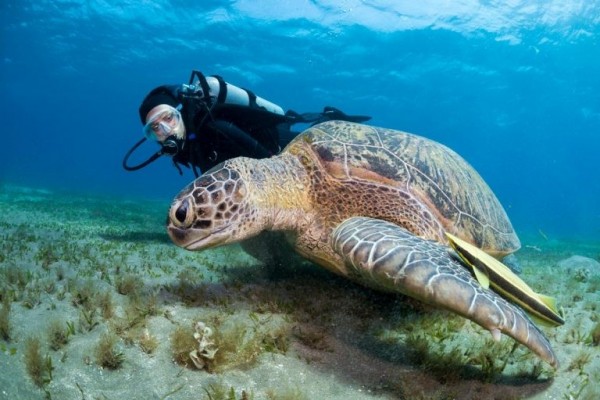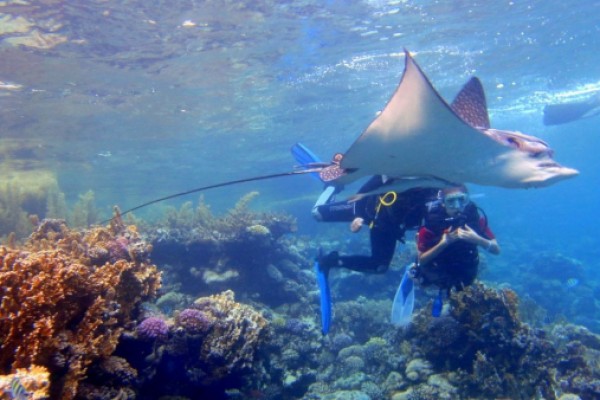STRAIT OF TIRAN
STRAIT OF TIRAN

Description
It is located at the mouth of the Gulf of Aqaba, with the shoreline of Sinai to the West and Tiran Island to the East. Known for its 4 offshore reefs close to Tiran Island: Jackson Reef, Woodhouse Reef, Thomas Reef, and Gordon Reef
Diving is varied and exciting for all levels. fantastic marine life: from the small reef fish right through to the larger fish, Tuna, Sharks, Manta Rays, Dolphins, and Turtles are a possibility, plus a magnificent variety of corals.
STRAIT OF TIRAN DIVE SITES:
- Jackson Reef
- Kormoran Wreck
- Laguna Reef
- Woodhouse Reef
- Thomas Reef
- Gordon Reef
Jackson Reef
This is the northernmost reef in Tiran and is known for the wreck, partially demolished in 1996, of the Cypriot merchant ship Lara, which sank here in 1985. Diving here usually begins on the southern side, which is sheltered from the waves and wind and where there is a large metal buoy, a fixed mooring - which is not far from the reef - and two other mooring points on the reef on water level: here the wall, cut through by some splits, descends steeply to the sandy floor (-45 meters). Going westwards, you will see some gorgonians and a splendid red anemone at a depth of 28 meters. This is followed by a plateau that is connected to Woodhouse Reef by a saddle. The southwestern corner of Jackson Reef, where numerous fire corals can be seen, is subject to the currents, which can be extremely violent. If conditions are right (especially when the tide is ebbing), it is possible to drift dive on the eastern part of the reef. Here, about 15 meters down, is a sandy ledge that sinks into the abyss to the north. It is quite easy to spot turtles (Eretmochelys sp.) and large pelagic fish in this zone. Among the latter are White-tip reef sharks, Grey reef sharks, and Hammerhead sharks, which are especially numerous from July to September.
Woodhouse Reef
Woodhouse Reef is narrow and long, diving here is done only as drift dives and only in good weather conditions. The best time is usually the morning because of the direct sunlight. The most interesting part of the reef is the northern half of the eastern side with a canyon starting at 30 meters and running parallel to the main axis of the reef until it reaches a sandy ledge. Lots to see there: from red anemones to great potential for sea turtles, jackfish, and eagle rays.
Thomas Reef
This reef is one of the most spectacular diving sites in the northern Red Sea for both recreational and Technical Divers. The lack of mooring points makes drift diving necessary: The southern corner of the reef is the classic starting point for your underwater itinerary, which continues along the eastern side where the wall, rich in multicolored coral, descends to a sandy plateau that begins at a depth of about 25 meters and has a slight incline. Here you can see large Alcyonarians, impressive gorgonians, and colonies of black coral, Antipatharians with their characteristic spiral shape. At a depth of 35 meters, a splendid and extremely deep canyon opens out, running parallel to the reef and crossed by a series of impressive arches. At the northeastern corner of the reef, you may come upon a very strong counter-current. If you can get past this point and conditions are favorable, you can go around the entire reef. This will allow you to explore the northern wall, which has some nice shelters and splits, and the western one, where you will see many crevices and caves, lovely gorgonians, and a wealth of fauna consisting of sea turtles, and reef fish. An extraordinary, grandiose marine environment. You may come upon an exceptional array of fauna, with large pelagic fish, especially the Whitetip reef shark.
Gordon Reef
Gordon Reef is easily identified by the wreck of the Panamanian cargo ship Loullia which crashed in 1981.
The fact that there is a fixed mooring on the southern side and a wide and rather shallow (10-24 meters) plateau that fans out in a south-westerly direction, makes this dive site safer than the preceding ones. A red and white beacon lies on the southwestern corner.
The first dive starts off from the mooring point and winds in an easterly direction and then northwards along the eastern side of the reef. Halfway along this side, you can see many metal drums scattered at a depth of 20 meters. From here you can either double back to the starting point or make a drift dive and proceed north; in this case, you will come across a rather small sandy plateau on which some Garden eels live.
You can also explore the vast plateau that extends in a southerly direction. After reaching the sand-filled depression with a vaguely circular shape (known as the ‘Amphitheater’ or ‘Shark Pool’) you will pass by a mass of cables and metal bars. From here you can go back to the starting point either by heading towards the reef or, after crossing a zone filled with fire corals, by drift diving along the western side.
Enjoy the various species of coral, small nudibranches hidden in the crevices, and the soft corals, you can encounter as well as White Tip Reef Sharks and Eagle rays, Octopus, and different types of eels such as Moray, Peppered and Gold edged morays.
 -
-
 -
-
 -
-




